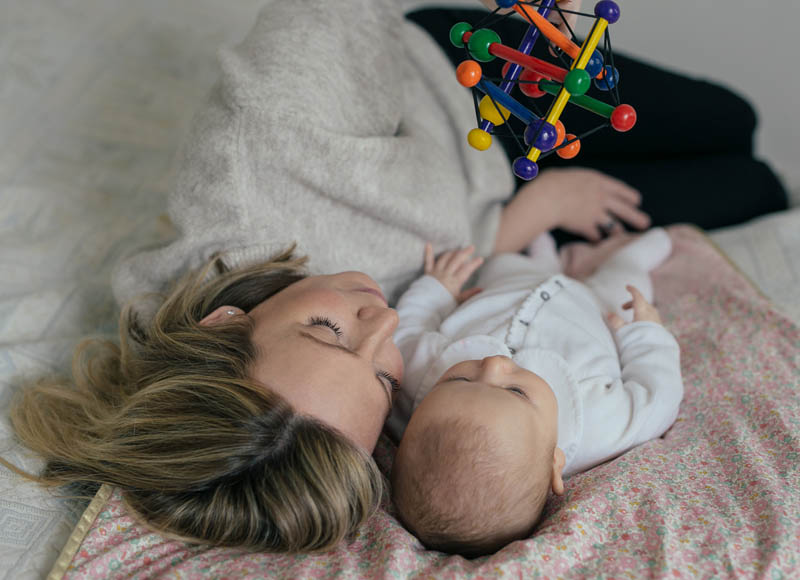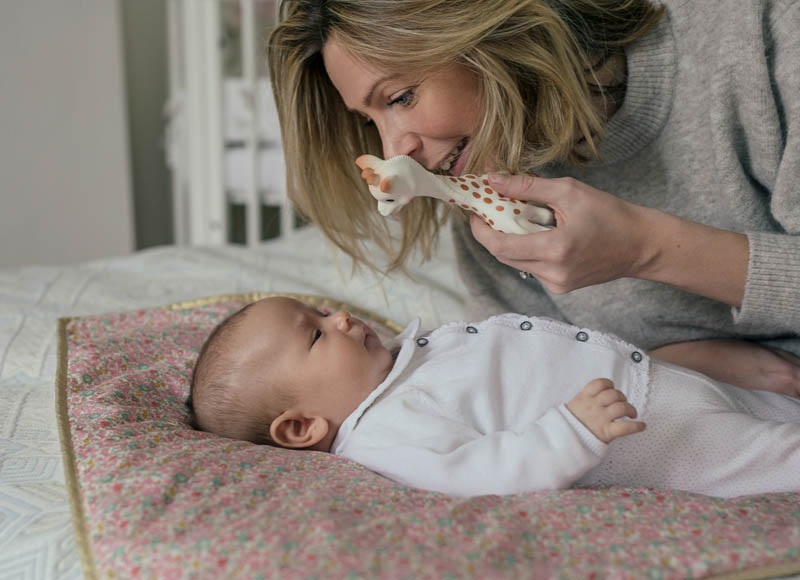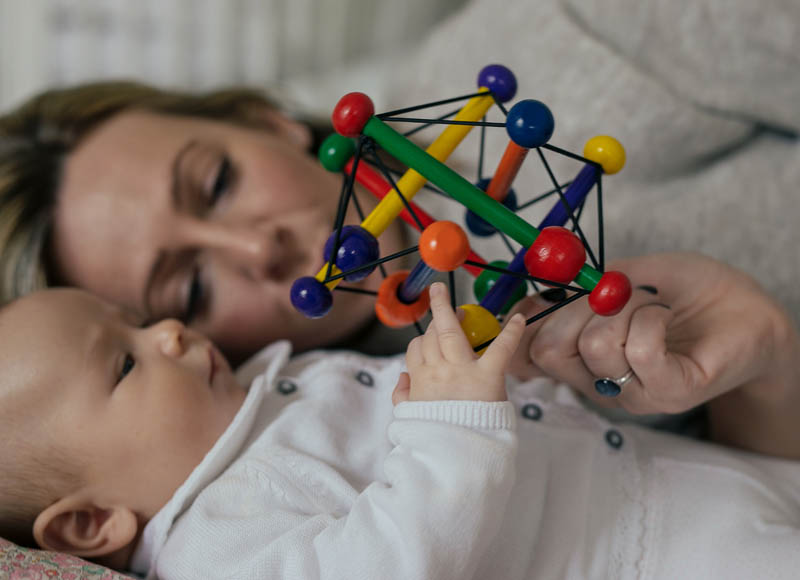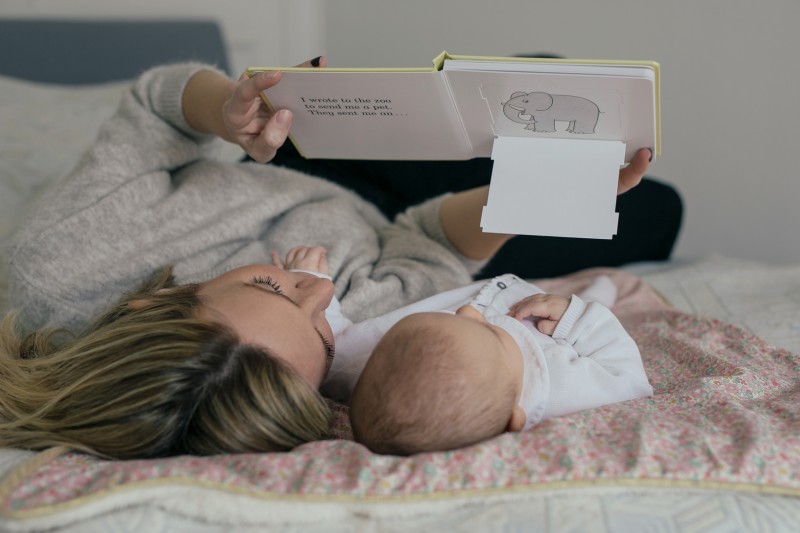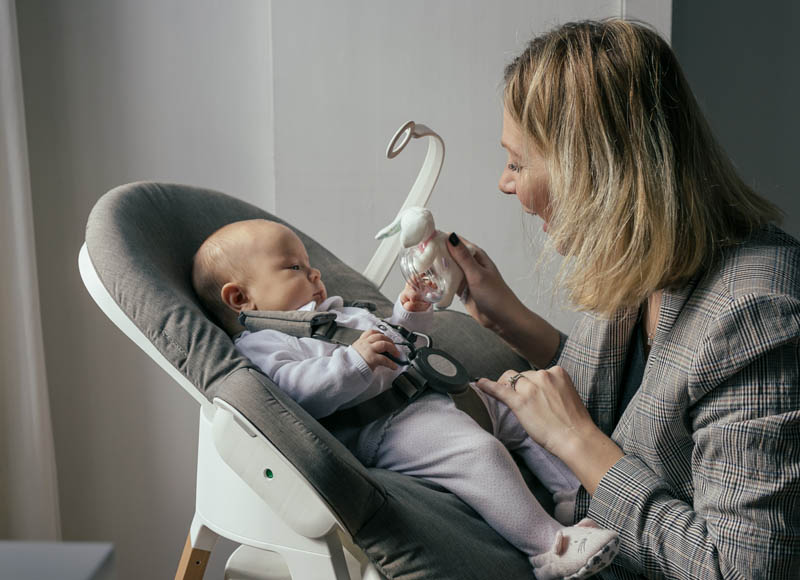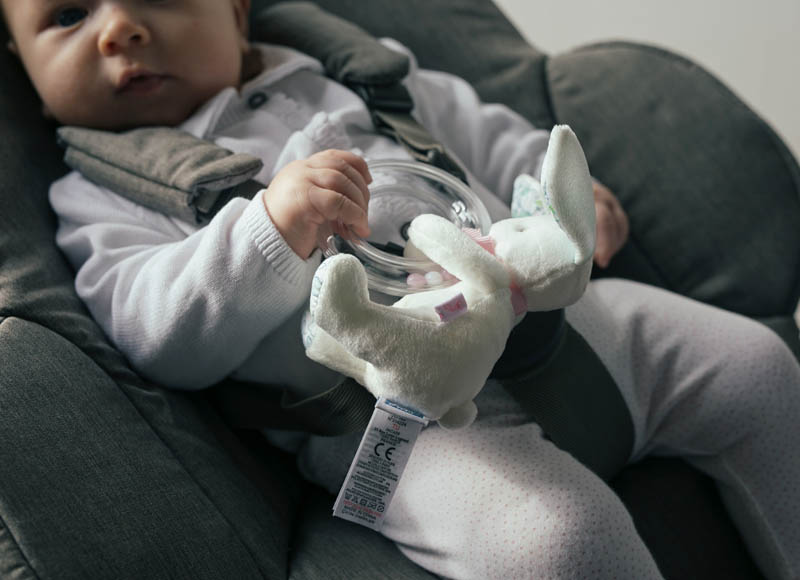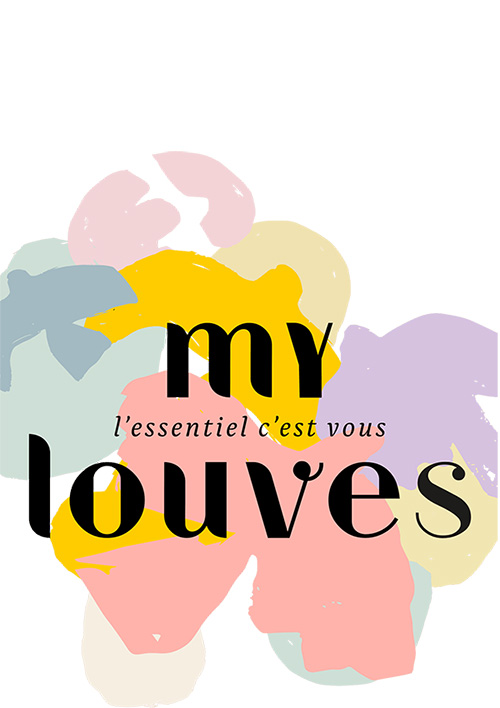A sweet time of complicity but also an essential learning tool for growing up and waking up to the world, play is an integral part of a toddler’s everyday life. Still, with a baby who evolves more every day, we do not always know what toys and what activities to offer. To learn how to play with a baby and accompany him or her from 0 to 12 months, follow these tips created with the help of Stokke.
The baby’s first three months
During the first year, everything is new and the baby is learning. It’s like a game for him, a real “job”, as Maria Montessori explains. The role of the parents is then to be next to him, to gently guide him in his discovery and to arrange the home environment according to the preferences of their child. “For the first three months, the parent-child symbiosis is essential,” explains Emmanuelle Langlois, an expert psychomotor specialist in early childhood. The parent discovers his baby, lays the foundation of the exchange, each person learns to know each other and to get along.”
1 to 2 months
During this period, do not hesitate to carry your baby as much as possible: “It creates a back and forth between the parent and the child, what is called a tonic dialogue, which allows parents to understand their baby just by contact. Additionally, I always encourage baby massage, a wonderful way to form the connection.” By imitating the babbling of your child, by singing lullabies to them, by exaggerating the expressions of your face, by speaking to them: it is these simple little moments which lay the foundations of the game and establish the emotional security of the baby. “Playing with a baby during the first months will promote early interactions and visual and physical exchanges,” summarizes the psychomotor specialist.
Which toys to choose?
“I advise not to over-stimulate babies, who already have a lot to discover around them. It is above all the physical contact that matters at this age. However, I like breastfeeding collars: when they are worn, babies like to grab something. These adapted necklaces allow them to grasp and chew while being in touch with their mother.”
From 2–3 months
“I insist on putting babies on the ground as often as possible, rather than in a seat where they are passive and limited in their interactions,” says Emmanuelle Langlois. The ideal setup: to lay the baby on a carpet and to have beside him, or even a little behind him, an activity gym. “Hanging objects will catch his eye, push him to move his head and make him want to turn around. As the baby’s tone is global, by turning his head he will slowly engage the shoulders, the column and the pelvis and this is how he learns to turn on his own.
Which toys to choose?
“I advise to put little toys around the baby, but to switch them out often. As for colors: they need contrast! The first weeks the baby can only see about 20 cm ahead, and it’s pretty blurry. His vision improves week after week, and it’s the contrast that attracts him the most.”
- Wobbly toys, which have a weighted bottom and tilt without falling, to make the baby want to reproduce his gesture when he hits it;
- Sensory sound balls, rattles, easy grip balls, mirrors.
From the 4th month: when the baby starts to turn on his belly
It is important for the baby to spend time on the floor, learn to curl, turn around and discover his body. “We can take advantage of this period to give small foot massages when they are turned on their stomachs: this allows them to become aware of this part of their body,” advises Emmanuelle Langlois. Once on the stomach, children can manipulate the objects in different way, play differently and the grip becomes more voluntary.
Which toys to choose?
“We suggest objects that stimulate manipulation and the senses, with a grip and different materials.”
- Sensory sound and visual rattles, toys with different materials, themed sensory baskets (you can offer the baby some toys in different materials: metal, wood, fabrics…);
- Musical instruments: maracas, bells, castanets with a handle, small rain sticks. The key is to ensure that the movement is easy for the baby to do;
- A basket filled with different kinds of balls: large, small, plastic, spiky, holey…
When the baby is sitting up
“The position normally begins at the same time as the movement starts and when they start using four legs: there is a lot going on at this time!” enthuses the psychomotor specialist. The baby now has another way of seeing things, his hands are free and he can manipulate more objects.
Which toys to choose?
“I always advise to opt for simplicity,” explains Emmanuelle Langlois. “Playing with your child means knowing how to observe and offer activities that seem to really please him.”
- Sorting boxes with shapes: the goal is not that the baby knows to put the round in the round and the square in the square, but he wants to embed the object and to repeat his gesture.
- Small books: we suggest hard copies because they like to manipulate the books first, before the story.
- Cubes to learn to stack them and make little towers.
You can also make their first fort, create small obstacle courses on the floor (with pillows, etc.), provide a crate of toys that babies love…
A few tips from Hana, photographer and mum of Livia, 3.5 months…
Can you introduce yourself?
I am 35 years old, I come from Slovakia. I live in Paris for 5 years now, after having lived in London for 10 years and in Austria. I am a lifestyle and fashion photographer, and I married a French man, with whom I had a little girl, Livia, who is now 3 and a half months old! I share a little of my daily life on my Instagram account @journeyintolavillelumiere.
How do you capture Livia’s attention in daily life?
As Livia is still small, it mostly involves a lot of eye contact and facial expressions. I talk to her a lot, and I like to sing my own little nursery rhymes to her. Music is very important in my day-to-day life, and like my mom who sang songs to me from an early age, I constantly sing with Livia.
What have been your first games with her?
As she is only 3 and a half months, the only way to really play with her for the moment is to place in front of her colored toys, preferably very close to her face to capture her attention! Finally what amuses her the most are our faces! We make funny faces, sounds, movements to get her attention and interact with her …
She is still very young, but can you tell if she has a favorite activity with you?
She loves being seated in her Stokke lounger, attached to her Steps high chair, next to us, to interact with us. She also likes to lie on the changing mat in the bathroom: we spend a lot of time there, and I have installed a small mobile that she can observe while I change her clothes. It’s also where I have her do small exercises with her legs (if she has a stomach ache for example). We sing, and we always spend a good time preparing the bath.
What is the first toy you gave to your daughter? Your favourite?
She has so many toys! I think my favourites, like her, are those which make noise and are very colorful. I really like the musical turtle I bought her to soothe her at night. I also love small books, even if for the moment we play mostly with rattles…
How do you incorporate your Stokke chair into your games?
What I prefer with the Steps high chair is that Livia is not flush with the ground but at our height, so that the connection with it is more immediate. I love being able to put her on her chair and just talk to her, play or sing with her, know that she sees the same things as us. Thanks to the small recliner, we use her Stokke chair every day.
Find Hana’s beautiful photos on her Instagram account @journeyintolavillelumiere and on her website, www.journeyintolavillelumiere.com.
Creators: Stokke x Les Louves
Photo credit: BellyBalloonPhotography x Les Louves
Our thanks to Emmanuelle Langlois, psychomotor and author of the blog How I play with my mome for her valuable advice.
M.R.
Translation: Ashley Griffin
Read more on Les Louves
15 minutes/day: 4 ideas to spend quality time with your child
Your first outings together: how to introduce your child to the world around him
The first nights: advice and tips to help your baby sleep
